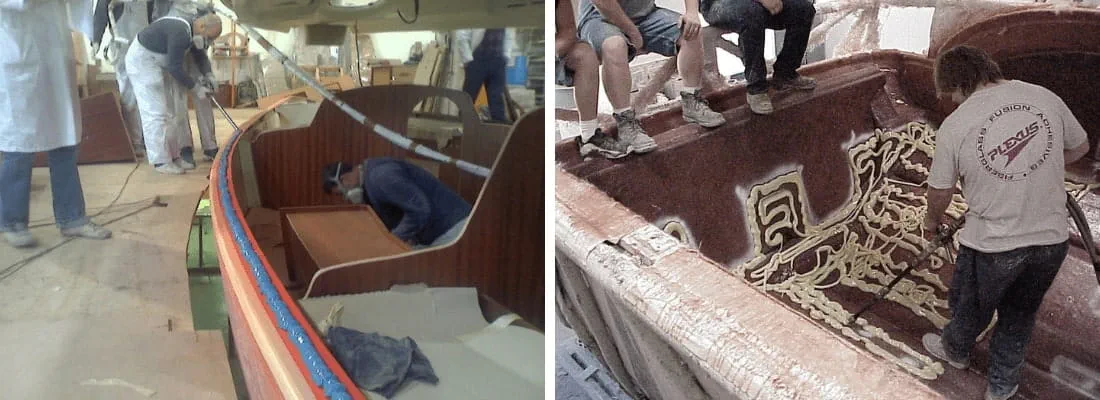Bonding composite materials is a real challenge. Structural adhesives can be used to bond different materials: they don’t cause problems either to composites, which do not react well to soldering or drilling, or to aluminium or to other light metals that can easily be deformed by heat. In addition, structural adhesives allow great freedom for designers and enable the use of automated processes.
Advantages of adhesives with respect to traditional mechanical systems
Structural adhesives produce stiff and highly resistant – practically everlasting – bonds between different sub-strata, even in conditions of extreme stress. That means they offer considerable advantages with respect to traditional mechanical systems.
As is often the case, they were first developed for the aeronautical sector and have been used extensively by companies like Airbus and Boeing to build large, new-generation aircraft: a clear demonstration of the levels of technology and safety they offer. Structural adhesives are generally made from epoxy, polyurethane, or acrylic polymers. Their common features are speed and ease of application and the ability to bond different materials. They are also very cost-effective.
These features make them suitable for an extremely diverse range of uses. As they can be used to glue different materials, they do not cause problems either for composites, which do not react well to soldering or drilling, or for aluminium or other light metals that can easily be deformed by heat. In addition, with soldered or mechanical joints, it is not possible to work on certain shapes or on very tight corners. Structural adhesives, however, give designers great creative freedom. It is also worth noting that these adhesives also make it possible to use automated processes.
Features of structural adhesives
In future, we will undoubtedly see the use of structural adhesives for bonding composites grow increasingly, especially in high-technology sectors such as aeronautics, electronics and maritime industry and boat building.
Only a few adhesives satisfactorily meet the need to create structural bonds that provide resistance to fatigue, cracks and breaks and remain stable in terms of size and shape in the most diverse environmental conditions. Epoxy resins are mainly used for their flexibility of use. Depending on their formulation, they polymerise at both ambient and very high temperatures. Polymerisation time can range from a few minutes to many weeks, depending on the thinners or fillers used, so they can be made to measure for a wide range of uses.
Structural adhesives are used instead of mechanical joints for a variety of reasons. Mechanical joints can cause fatigue at and around the attachment point and thus cause cracks or, in certain cases, substrate failure. Adhesives can prevent these problems. The line of adhesion between the two materials causes less stress because the load is applied over a larger surface. By forming a layer between the two materials, the adhesive absorbs the energy of any impact, enables thermal expansion and behaves like a fatigue resistance layer.

Photo credit: Scott-Bader
Choosing and using the adhesives for the marine industry
It is always best to choose the adhesive at the design stage, when the parameters can be identified and decided on, thus facilitating the selection process.
The first step is to define the limits imposed by the process and the end-use conditions of the bonded product. The next step is to choose the substrate and adhesive. The best strategy is to involve the adhesives producer as early as possible to prevent any problems arising from making the wrong choice. Such problems could arise at a later stage, causing production delays and failures in the operational phases.
The marine industry, which uses large quantities of fibreglass, is traditionally very attached to “classic” assembly systems. When traditional assembly methods are used, the different parts of the boats are joined by layering the fibreglass or using marine putty. Conditions such as temperature, UV radiation, humidity, collisions, chemical products and general wear and tear can severely weaken the joints and even cause them to fail. This can cause cracks that can hamper the boat’s performance.
Structural adhesives cuts construction time
Structural adhesives, however, create a cross-linked chemical bond and in essence fuse the two fibreglass surfaces together. This bond holds even when the fibreglass delaminates or breaks. Gluing not only cuts construction time and costs, but also produces a strong, durable and flexible adhesion line that can absorb energy and withstand cracks and splits.
When choosing adhesives for nautical applications and boat building, the main points to consider are fatigue resistance, flexibility, the ability to absorb shocks and vibrations caused by wave and wind movement and, in the case of racing boats, high speeds.
In recent years the use of these adhesives has become widespread, although some resistance remains in the nautical sector, nearly always as a result of incorrect use of the products. Research and development are ongoing and the range of products available is already very wide.
In short, structural adhesives are increasingly seen as producing the best bonding system.

